

Tempest Recipes: Snare Drums. EarSketch. Gibber.mat.ucsb. Sonic Pi. Tidal - Home. GenSession : un outil convivial pour composer des mélodies. New Music – Publishers – Editors – Consultants – Technologists. GitHub - overtone/overtone: Collaborative Programmable Music. SuperCollider » SuperCollider. Karlheinz Essl: RTC-lib - Real Time Composition Library for Max and Pd (1992-2015) Karlheinz Essl cuts off the cosmic suggestion Real Time Composition Library Software library for algorithmic composition with Max copyleft 1992-2015 by Karlheinz Essl and others Index Abstract.
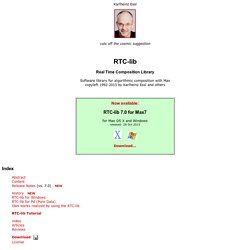
Saebekassebil/teoria. VexTab Tutorial. What is VexTab?
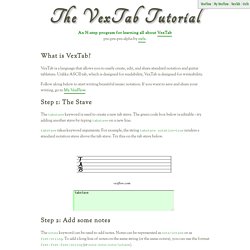
VexTab is a language that allows you to easily create, edit, and share standard notation and guitar tablature. Unlike ASCII tab, which is designed for readability, VexTab is designed for writeability. Follow along below to start writing beautiful music notation. If you want to save and share your writing, go to My VexFlow. Teoria.js - Music Theory in JavaScript. Free software that simplifies songwriting - Hookpad. In addition to being a great songwriting tool, Hookpad is a powerful MIDI creation platform.
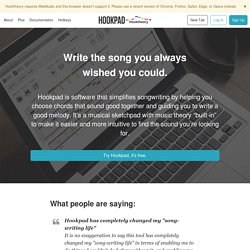
With a single click, Hookpad's arrangement can be exported to MIDI and into a Digital Audio Workstation (Ableton Live, FL Studio, Logic Pro, GarageBand, ...) for additional production / modification. With intelligent harmony / chord fills, and the ability to independently shift the tonal center of each track, incorporating Hookpad into your workflow will enhance your creativity and productivity as a songwriter or producer. Need a quick pad fill for C → G → am → F? Drop those chords into Hookpad, tweak the mix to your liking, send to MIDI, and in less than a minute, you are on to the next thing. Beginner's Guide to Writing Better Bass Lines. When composing a song, the obvious place to focus on is the melody.

In fact, I wrote a series of tutorials providing tips for composing melodies recently, which you may find useful if you're struggling with this part of song writing (Part 1, Part 2, Part 3). Whilst a catchy melody is arguably the single most important element to get right, it's also seriously beneficial to pay close attention to the bass line too. Musicians and composers have been using bass lines to spice up their scores for centuries, across all genres of music from classical to blues, jazz to pop. In this tutorial you'll pick up some tips, tricks and ideas to help you improve your compositions by creating better bass lines.
Feature: 004 -FM Synthesis : Part 1 @ SonicState.com. Some discussion of ratios is included in the video.

When using a virtual analog, you probably won't have an option to set ratios between modulator and carrier. Instead, you'll set the pitch of the modulator by adjusting its pitch setting. The PDF file below has a convenient table for this. If that sounds at all like gibberish, it won't after you watch the video. 30 Comments... The Fundamentals of Synthesizer Programming. Sound Synthesis Education ~ Synth.tk. Creating Sound. 26 essential synth tutorials. Thanks to today's über-powerful, super-affordable software instruments, making synth-based music has never been easier.

Valhalla Freq Echo. Reaktor User Library : Entry. Audio - Bandlimited waveform generation. Advanced Programming Techniques for Modular Synthesizers. Table of Contents.
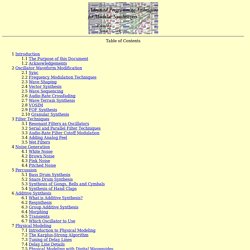
Pitch Shifting Using The Fourier Transform. With the increasing speed of todays desktop computer systems, a growing number of computationally intense tasks such as computing the Fourier transform of a sampled audio signal have become available to a broad base of users.
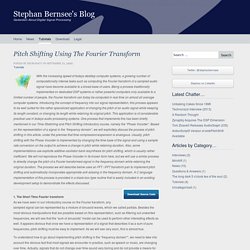
Being a process traditionally implemented on dedicated DSP systems or rather powerful computers only available to a limited number of people, the Fourier transform can today be computed in real time on almost all average computer systems. Introducing the concept of frequency into our signal representation, this process appears to be well suited for the rather specialized application of changing the pitch of an audio signal while keeping its length constant, or changing its length while retaining its original pitch.
This application is of considerable practical use in todays audio processing systems. SmbPitchShift.
Dennis DeSantis. Youtube. Seaquence. Outils en ligne pour écouter de la musique. AUDIO SOURCES SAMPLES LOOPS. Audio Geek Zine. Pitchfork. Reactive Music. Latest songs from music blogs worldwide / Hype Machine. Experience n°13 - L'Electro Dance Club. DummyMag.com. D-type Flip Flop Counter or Delay Flip-flop. Interfacing with a DAC (Digital/Analog Converter) for Sound Synthesis with the Netduino. In previous two posts, I created a midi interface for the Netduino.

For kicks, here's what it looks like soldered rather than on the breadboard (and beside it, a shot of the disaster my desk has become during this project. There's actually a Commodore 128 in the rubble to the right): Making waves – Open Music Labs’ DSP Shield – Arduino – freeRTOS. There’s a great new Arduino Uno (pre-R3) Shield available from Open Music Labs.

Their Audio Codec Shield is an Arduino shield that uses the Wolfson WM8731 codec. It is capable of sampling and reproducing audio up to 88kHz, 24bit stereo, but for use with the Arduino it is practically limited to 44kHz, 16bit stereo. The Audio Codec Shield has 1/8″ stereo input and headphone output jacks, a single pole analogue input aliasing filter, and 2 potentiometer for varying parameters in the program on the fly. The Open Music Labs provides a some libraries and code examples for use with the Arduino IDE, and also with the Maple IDE.
But, rather than just use the existing code, I thought it would be fun to develop some freeRTOS libraries from their basis code. ARDUINO DSP. Recording Impulse Responses. With growing computing power over the last decade, convolution plugins have become commonplace. Some of the most common ones include Audio Ease Altiverb, Logic’s Space Designer, Avid TL Space, Waves IR-1 and McDsp Revolver. They are usually packaged with large and useful libraries of impulse responses (more on what all this means below), but what makes them really powerful is the fact that it is quite easy to record and use your own impulse responses. The Synthesis ToolKit in C++ (STK) Algorithmic symphonies from one line of code. Lately, there has been a lot of experimentation with very short programs that synthesize something that sounds like music. I now want to share some information and thoughts about these experiments.
First, some background. Toy of the Month.
Beat making. News. ...KB6.de... Free Drum Samples - Free Downloads - Drum Kit - Wav Samples. Tsugi. Ableton tuto. Melodic Step Sequencing with Ableton Push. Requirements: Latest version of Live 9 and Push firmware installed Ableton's Push has already revolutionized the hands-on process of composing electronic music with its innovative scaled note entry and drum programming modes. The true beauty of this hardware is that it's designed to continue evolving with future firmware and software updates to Live—and with their latest revision, they've added smooth, MIDI clip-integrated step sequencing.
Le Tournedisque. Electro-Drops blog d'actualité musicale, dubstep, électro, house, mixtapes. WEBZINE ELECTRO. Empreintes-digitales. Actualites Electroniques : l'actualite de la musique electronique au quotidien. Minimal. Note names, MIDI numbers and frequencies. Note names, MIDI numbers and frequencies are related here in tables and via an application that converts them. The musical interval between two notes depends on the ratio of their frequencies. See Frequency and Pitch for more details and an introduction to frequency and pitch. Audio and production tutorials, from beginner to advanced.
Robot Koch, Beatmaker polyvalent Les robots se nourrissent de musique et de silence. Voilà la délicate balance qui les fait fonctionner. Vers l’âge de 10 ans j’écoutais les cassettes de Soul et de Funk de ma mère, ainsi que pas mal de trucs de la Motown. A 15 ans j’ai commencé le piano et la batterie pour ensuite continuer dans un groupe de Métal et d’hardcore jusqu’à ce que je commence à mixer, puis à produire, vers l’âge de 20 ans… Aujourd’hui j’en ai 32, ce qui veut dire que cela fait un petit bout de temps que je fais ça maintenant !